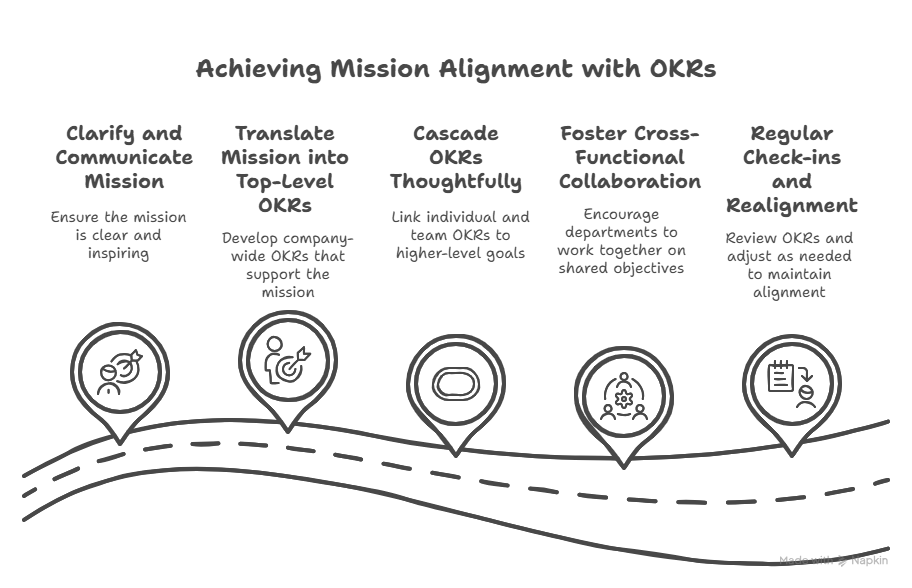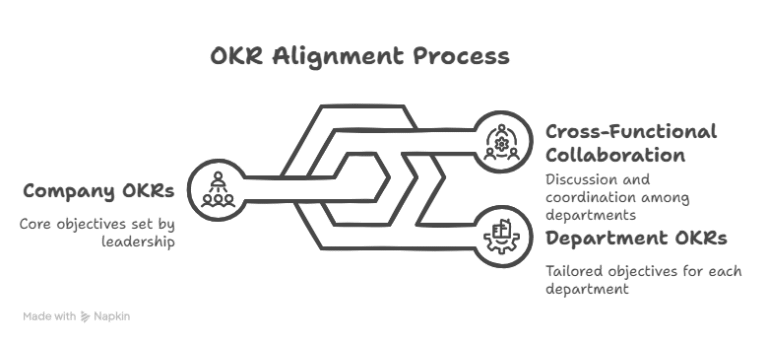Introduction
Ever feel like your team’s working hard, but not really getting anywhere? Like you’re all rowing, but in different directions? That’s where mission alignment comes in, and when paired with OKRs (Objectives and Key Results), it’s like rocket fuel for your organization. In this article, we’re going to dive into the world of mission alignment, explore why it’s crucial for OKR success, and show you how to get your whole team pulling in the same direction. Whether you’re a startup founder or a manager in a large corporation, buckle up – we’re about to turn your mission statement from a dusty plaque on the wall into a living, breathing force that drives your OKRs and your success.
What is Mission Alignment?
At its core, mission alignment is about ensuring that every action, decision, and goal in your organization supports your overall mission. It’s like a game of connect-the-dots, where your mission is the final picture, and each dot represents an objective or key result.
But why does it matter? Here’s the scoop:
- It gives meaning to work: When people understand how their efforts contribute to a bigger purpose, they’re more motivated and engaged.
- It improves decision-making: A clear mission acts as a north star, guiding choices at every level.
- It fosters unity: A shared mission brings teams together, breaking down silos and encouraging collaboration.
- It drives focus: With a clear mission, it’s easier to prioritize initiatives and allocate resources effectively.
The Mission-OKR Connection: A Match Made in Heaven
Now, let’s talk about how mission alignment and OKRs work together. Think of your mission as the destination, and OKRs as the GPS guiding you there. Here’s how they complement each other:
1. Cascading Alignment
Your mission informs your company-wide OKRs, which in turn inform team OKRs, which then inform individual OKRs. It’s like a waterfall of purpose, ensuring that even the most granular tasks are contributing to the big picture.
2. Measurable Progress Towards Vision
While a mission statement can feel abstract, OKRs provide concrete, measurable steps towards achieving that vision. They turn lofty aspirations into actionable goals.
3. Adaptive Strategy
OKRs allow you to adjust your course while keeping your mission in sight. As market conditions change, you can pivot your objectives while still staying true to your overall purpose.
How to Achieve Mission Alignment with OKRs
Alright, so how do we actually make this happen? Here are some practical steps:
1. Clarify and Communicate Your Mission
First things first – make sure your mission is clear, compelling, and well-communicated. It should be short enough to remember, but meaningful enough to inspire.
2. Translate Mission into Top-Level OKRs
Work with leadership to create company-wide OKRs that directly support your mission. These should be ambitious and inspiring, setting the tone for the entire organization.
3. Cascade OKRs Thoughtfully
As teams and individuals set their OKRs, encourage them to explicitly link their objectives to higher-level OKRs and ultimately to the company mission. This creates a clear line of sight from daily tasks to overall purpose.
4. Foster Cross-Functional Collaboration
Mission alignment often requires different departments to work together. Use OKRs to create shared objectives that encourage collaboration and break down silos.
5. Regular Check-ins and Realignment
Schedule regular sessions to review OKRs and discuss how they’re contributing to the mission. This is a chance to course-correct and ensure ongoing alignment.
Common Pitfalls in Mission Alignment
Watch out for these traps:
- Mission Myopia: Don’t be so focused on the mission that you ignore market realities or customer needs.
- Forced Alignment: Not every single task needs to directly tie to the mission. Allow for some flexibility.
- Neglecting Culture: Remember, mission alignment isn’t just about goals – it’s about fostering a culture that embodies your mission.
- Over-complicating OKRs: Keep your OKRs simple and focused. Too many objectives can dilute your mission alignment efforts.
Case Study: Spotify’s Mission-Aligned OKRs
Let’s look at a real-world example. Spotify’s mission is to “unlock the potential of human creativity by giving a million creative artists the opportunity to live off their art and billions of fans the opportunity to enjoy and be inspired by it.”
Here’s how they might cascade this into OKRs:
Company OKR:
- Objective: Become the #1 platform for independent artists to showcase and monetize their work
- Key Result 1: Increase number of independent artists earning a living wage through Spotify by 50%
- Key Result 2: Achieve 85% artist satisfaction rating
Team OKR (Artist Relations Team):
- Objective: Empower independent artists with tools for success
- Key Result 1: Launch artist education program with 10,000 participants
- Key Result 2: Increase average artist earnings by 25% through promotional features
Individual OKR (Marketing Manager):
- Objective: Boost visibility of independent artists
- Key Result 1: Implement 5 new promotional features for independent artists
- Key Result 2: Increase streams of independent artist tracks by 30%
See how each level of OKRs ties back to the overall mission? That’s mission alignment in action!
Conclusion
Mission alignment isn’t just a nice-to-have – it’s a must-have for organizations that want to thrive in today’s fast-paced, purpose-driven world. When combined with the power of OKRs, it creates a formidable force that can drive your organization to new heights. By ensuring that every objective and key result ladders up to your overall mission, you create a sense of purpose and direction that can energize your entire team.
Key Takeaways:
- Mission alignment gives meaning to work and improves decision-making across the organization.
- OKRs provide a practical framework for turning your mission into measurable, actionable goals.
- Cascading OKRs from company-wide to individual levels ensures alignment at every tier of the organization.
- Regular check-ins and realignment are crucial to maintain mission focus over time.
- Balancing mission alignment with flexibility and market realities is key to long-term success.
Frequently Asked Questions
- How often should we revisit our mission statement?
While your core mission shouldn’t change frequently, it’s good to review it annually to ensure it still resonates and aligns with your long-term vision. Use this review to refine the wording or emphasis if needed. - What if some team members struggle to see how their work connects to the mission?
This is a common challenge. Try working with these team members to map out how their roles and objectives contribute to higher-level goals. Sometimes, it helps to bring in perspectives from other departments to illustrate the bigger picture. - Can startups benefit from mission alignment, or is it just for established companies?
Absolutely! In fact, startups can often benefit even more from strong mission alignment. It helps maintain focus during the crucial early stages and can be a powerful tool for attracting talent and investors who believe in your vision. - How do we balance mission alignment with the need to pivot or explore new opportunities?
Your mission should be broad enough to allow for pivots while still providing direction. If you find a truly promising opportunity that doesn’t align with your current mission, it might be time to reassess and potentially evolve your mission. - What’s the best way to communicate our mission-aligned OKRs to the entire organization?
Transparency is key. Consider creating a visual “OKR tree” that shows how different levels of OKRs connect to the mission. Regular all-hands meetings, internal newsletters, and collaborative OKR-setting sessions can also help reinforce the connection between daily work and overall purpose.
Further Reading
- “Start with Why: How Great Leaders Inspire Everyone to Take Action” by Simon Sinek
- “Measure What Matters: How Google, Bono, and the Gates Foundation Rock the World with OKRs” by John Doerr
- “Aligned: Connecting Your True North to the Work You Do Every Day” by Hortense le Gentil
- “The Advantage: Why Organizational Health Trumps Everything Else In Business” by Patrick Lencioni
- “Drive: The Surprising Truth About What Motivates Us” by Daniel H. Pink


